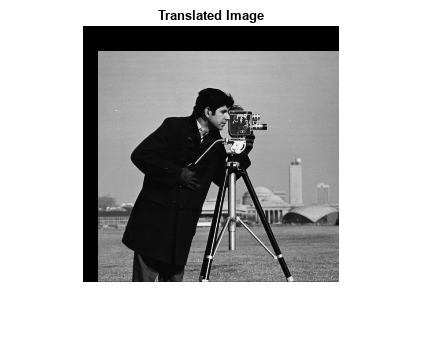Translate an Image Vertically and Horizontally
This example shows how to perform a translation operation on an image using the imtranslate function. A translation operation shifts an image by a specified number of pixels in either the x- or y-direction, or both.
Read an image into the workspace.
I = imread("cameraman.tif");Display the image. The size of the image is 256-by-256 pixels. By default, imshow displays the image with the upper right corner at (0,0).
imshow(I)
title("Original Image")
Translate the image, shifting the image by 15 pixels in the x-direction and 25 pixels in the y-direction. Note that, by default, imtranslate displays the translated image within the boundaries (or limits) of the original 256-by-256 image. This results in some of the translated image being clipped.
J = imtranslate(I,[15, 25]);
Display the translated image. The size of the image is 256-by-256 pixels.
imshow(J)
title("Translated Image")
Use the OutputView name-value argument set to "full" to prevent clipping the translated image. The size of the new image is 281-by-271 pixels.
K = imtranslate(I,[15, 25],OutputView="full");Display the translated image.
imshow(K)
title("Translated Image, Unclipped")
See Also
imtranslate | transltform2d | transltform3d